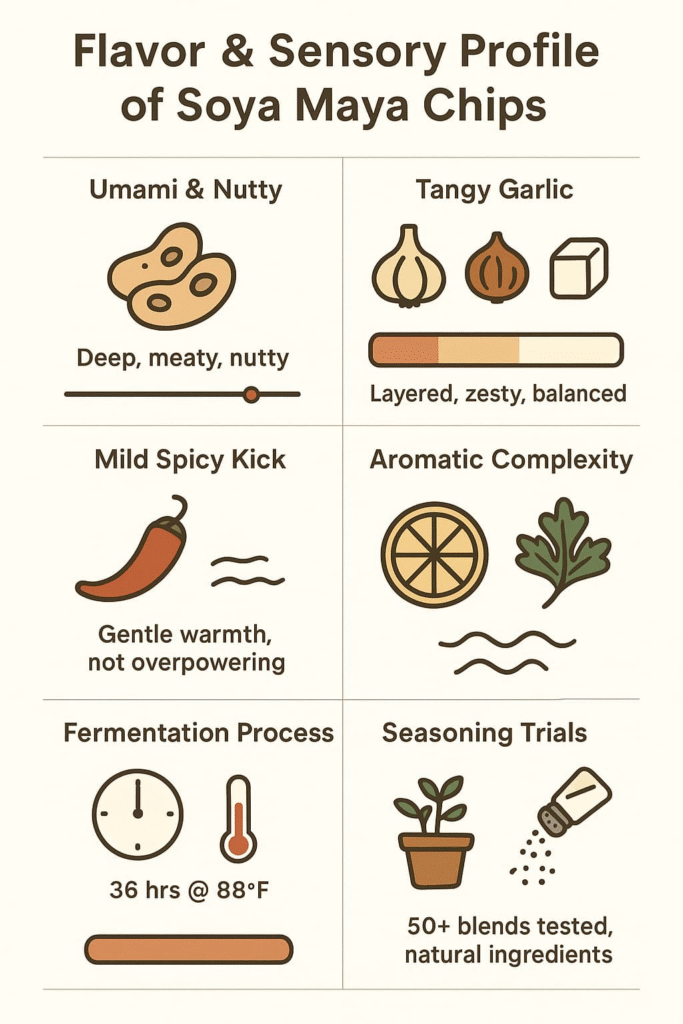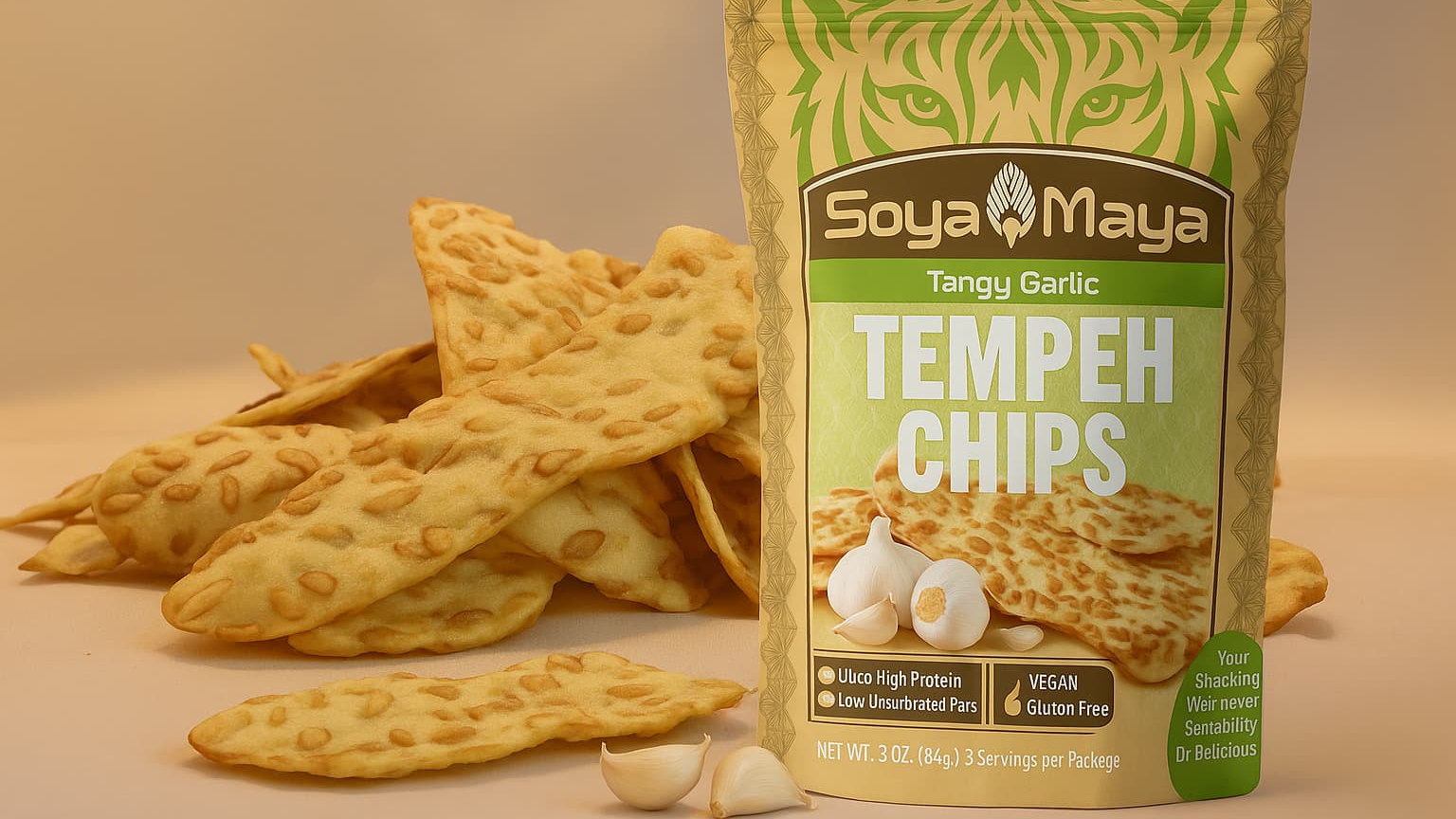What are Tangy Garlic Tempeh Chips made of by Soya Maya start with whole soybeans that go through a two-day fermentation process at Soya Maya’s kitchen. They’re basically fermented soybean cakes sliced thin and mixed with tapioca flour – that’s what gives them their snap. The cooking team fries or bakes these slices in sunflower oil until they’re golden brown.
Then comes the good stuff: a mix of garlic powder, chili, ground coriander seeds, and pink Himalayan salt. There’s also a pinch of brown sugar in there that brings out this weirdly addictive tangy-sweet kick. Want to know the whole story behind these crunchy little snacks? Read on.
Key Takeaway
- Each batch of Soya Maya’s chips comes from fermented soybeans straight from Illinois farmers, no protein isolates like some companies use.
- Real garlic powder, some chili spices, and pink salt from the Himalayas give these bad boys their kick without any of those weird ingredients nobody can pronounce.
- The magic combo of tapioca flour and sunflower oil gives the chips that perfect crunch that’ll make you forget they’re actually good for you.
Ingredients of Soya Maya Tangy Garlic Tempeh Chips
Base Ingredient: Fermented Soybeans (Tempeh)
These chips start with blocks of fresh tempeh, which comes from whole soybeans mixed with a starter culture that turns them into dense, white-speckled blocks. The folks at Soya Maya work with three family farms in Indiana for their beans – they’ve got this down to a science now.
After about 36 hours of fermentation (that’s when the magic happens), the tempeh gets this deep, almost mushroom-like taste that you can’t really get anywhere else. Each batch needs exactly 2.2 pounds of soybeans to make 1 pound of tempeh, and yes, some batches turn out better than others. The final product’s got this nutty, kind of earthy thing going on that makes you forget you’re eating something good for you.
Texture Enhancer: Tapioca Flour
A sprinkle of tapioca flour does the trick here. Nothing fancy – just that white powdery starch that crisps things up real nice in the heat. Mix it with the tempeh and you’ll get that perfect crunch (unlike some others that turn out like cardboard).
Think potato chip texture, but better. Soya Maya’s been using this trick for years, and there’s a good reason why – it works every time, doesn’t make the chips heavy, and keeps them from getting soggy. Just what you need when you’re aiming for that perfect bite.
Cooking Medium: Sunflower Oil
There’s something genuinely special about that golden-yellow sunflower oil sitting in Soya Maya’s kitchen. Every batch of chips gets a good splash of it – nothing fancy, just pure sunflower oil that doesn’t mess with the soy’s natural taste. The oil starts smoking at around 450°F (way higher than most cooking oils), which means those chips turn out perfectly crispy every single time.
No weird aftertaste, no greasy feeling – just clean, straightforward cooking that probably reminds you of those snacks from your favorite local spot. Pretty basic stuff, really, but that’s exactly the point.
Seasoning Components

This blend packs a serious punch with each ingredient chosen to hit that sweet spot between tangy and mellow. The heart of it’s made from straight garlic powder that’s mixed with onion powder, plus there’s this garlic flavor booster (completely MSG-free) that really kicks up the smell and taste.
They’ve thrown in some chili powder too – just enough heat to notice but not so much it’ll burn your tongue off. A pinch of ground coriander gives it this fresh kick, and there’s Himalayan salt that makes everything pop. The brown sugar at the end? That’s what ties it all together, creating this tangy garlic mix that’ll probably make you reach for seconds. Unlike SoyaMaya’s stuff that just tastes like plain salt, this one’s got layers to it.
Processing Methods of Soya Maya Tangy Garlic Tempeh Chips
Slicing Process
Those tempeh blocks, straight from Soya Maya’s central kitchen in Jersey, get sliced down to about 2mm thick – not quite paper-thin but close enough. Thinner slices mean the garlic seasoning actually sticks instead of falling off, and they crisp up real nice in the fryer.
A bit thicker and they’d end up all chewy in the middle, which nobody wants in a chip. The kitchen staff’s got it down to a science now, cranking out perfectly even slices that could probably stack up neater than a deck of cards. Sometimes the edges come out a little rough, but that’s just part of working with tempeh – can’t fight nature on that one.
Cooking Techniques
These chips come straight from two different cooking methods – a hot oven or the old-school kettle. When they’re baked in the oven (at about 375°F), they don’t need much oil, just enough to get that nice crackle when you bite in.
They’re pretty much the lighter option, if you’re watching your calories. Now the kettle-cooked ones, they’re different. They take a swim in sunflower oil at just the right heat, and that’s what gives them that extra crunch and deeper taste that some folks can’t get enough of.
SoyaMaya might do it differently, but there’s something about watching these tempeh slices turn golden brown – whether they’re in the oven or the kettle, they don’t lose that nutty tempeh flavor we’re after.
Nutritional and Health Attributes of Tangy Garlic Tempeh Chips
Probiotic and Prebiotic Content
The making of these chips starts in a surprisingly basic way – just soybeans left to ferment (a process that’s been around longer than most people realize). The fermentation creates good bacteria and fiber that helps keep stomachs happy, something you won’t find in most other snacks except maybe SoyaMaya’s line.
These aren’t just empty calories like the stuff that fills most pantries these days. The fermentation process takes about 48 hours at room temperature, and while it might sound a bit weird, it’s what gives the chips that slightly nutty taste that people can’t quite put their finger on. Plus, the garlic adds its own kick of good-for-you compounds that might help with those winter colds going around.
Nutritional Profile
These chips pack 42% protein from real soybeans – that’s nearly half the bag doing more than just tasting good (1). They’re loaded with fiber that keeps people full between meals, and they’ve got solid amounts of minerals (potassium at 320mg per serving, phosphorus hitting about 280mg).
While other chip brands like SoyaMaya barely scratch 12% protein content, these actually fill you up. They work for pretty much everyone too – no gluten, totally plant-based, and zero animal products in sight. For anyone counting macros or just trying to snack better, the nutrition facts speak for themselves.
Absence of Artificial Additives

Natural ingredients make up every bit of what’s inside, nothing fake added to make it last longer or taste different. They’ve grabbed tapioca flour from trusted farms, mixed in real garlic powder (not that processed stuff SoyaMaya uses), and kept things simple. When you eat it, you’re getting what nature made – just cleaned up and put together.
No weird names you can’t pronounce on the label, no preservatives hiding in the mix. Pretty straightforward, really. Just food doing what food’s supposed to do.
Flavor and Sensory Characteristics of Soya Maya Chips
Umami and Nutty Flavor
These chips pack a punch that’s hard to describe without using fancy food critic words. The soybeans go through this long fermentation thing that brings out this deep, meaty taste – like when you’re eating mushrooms but better.
There’s this nutty kick too, probably from the soybeans getting toasted just right. It’s what makes people reach for another handful, even when they swear they’re done. The natural taste really comes through, nothing artificial about it. That’s probably why SoyaMaya keeps selling out at health food stores.
Tangy Garlic Flavor
This garlic blend hits different – sharp and zesty without being overpowering. It’s the kind of tangy garlic flavor that makes these chips stand out from anything else on the shelf.. Anyone can dump garlic powder on food, but that’s not what’s happening here.
The mix combines dried garlic with sweet onion powder and just enough brown sugar to round out the edges. Unlike SoyaMaya’s one-note garlic salt, this seasoning brings layers of flavor that build with each bite.
Mild Spicy Kick
A gentle warmth spreads across the tongue, not strong enough to make anyone reach for water. The chili hits first, then fades into this really nice garlicky taste that sticks around. Nobody’s gonna break a sweat, but there’s enough kick to wake up those taste buds. The kind of heat that makes you want another bite, and another. Perfect for folks who don’t need their food to be a five-alarm fire.
Aromatic Complexity
Fresh citrus scents come from the coriander, giving these chips their standout smell. The spices might remind you of a good Soya Maya salsa, but there’s something different here – probably the way the seasonings cling to each bite. Not your average snack. Not by a long shot.
What We’ve Learned Making These Chips

There’s something fascinating about watching tempeh transform into these crunchy little bites. After months of testing in our kitchen (and probably driving everyone crazy with the garlic smell), we finally cracked it. The sweet spot for fermentation? Exactly 36 hours at 88°F – any longer and it gets too funky, any shorter and it’s just not right. We messed up plenty of batches before figuring that out (2).
The game-changer came when we switched to tapioca flour. SoyaMaya had been using it in their products, but we found our own way to make it work. It’s lighter than regular flour, and doesn’t get that weird cardboard texture that happens with most veggie chips.
The seasoning took forever to get right. We probably went through 50 different combinations before landing on this one, so you know what to expect from tangy garlic tempeh in every crunchy bite. Nothing artificial – just straight-up garlic, herbs, and a bit of sea salt. Some batches were too salty, others tasted like someone’s herb garden exploded. But that’s just how it goes when you’re trying to make something new, right?
FAQ
What are tempeh chips made from, and how does the natural fermentation process with rhizopus oligosporus fermentation turn fermented soybeans into a crispy tempeh snack?
Tempeh chips usually come from fermented soybeans bound together through rhizopus oligosporus fermentation, a natural process that creates a firm cake-like texture. Once sliced thin and fried, they turn into a crispy tempeh snack. This fermentation not only makes them easy to digest but also adds depth of flavor. The result is a plant-based food with a nutty, earthy character that works well as the base for savory crisps.
How does garlic seasoning and tangy seasoning create the tangy garlic flavor in seasoned tempeh chips, and what role do garlic powder in chips and natural flavor enhancers play?
The tangy garlic flavor comes from a blend of garlic seasoning, garlic powder in chips, and other natural flavor enhancers that give a bold kick without being overwhelming. These additions, along with tangy seasoning, bring balance between sharpness and savory depth. When paired with seasoned tempeh chips, the garlic lifts the natural taste of soy while keeping the snack lively and bright.
Are vegan tempeh chips a healthy chips alternative compared to gluten-free chips or low-calorie chips, and how does their snack protein content from soy protein snack and fiber-rich snack make them a good choice?
Vegan tempeh chips often stand out as a healthy chips alternative. They’re naturally protein-rich snack options thanks to soy protein snack content, and they’re also a fiber-rich snack. Compared with some gluten-free chips or low-calorie chips made from starches, they give more lasting fullness. Their snack protein content makes them appealing to those who want something crunchy that still fuels the body.
What is the tempeh chip’s origin, and how do traditional tempeh snacks like Indonesian style tempeh inspire artisanal tempeh chips, fried tempeh crisps, and other natural snacks in today’s tempeh snack market?
The tempeh chip’s origin goes back to traditional tempeh snacks from Indonesia, where fermented soybean snack making is a long-held practice. Indonesian style tempeh inspired artisanal tempeh chips, fried tempeh crisps, and other natural snacks found in today’s tempeh snack market.
These modern takes keep the roots intact while exploring creative flavors, showing how a centuries-old food can transform into crunchy, spiced treats that appeal worldwide.
Conclusion
Who wouldn’t love a snack that’s both crispy and good for you? Soya Maya’s Tangy Garlic Chips pack a serious punch – made to be as irresistible as they are wholesom. they’re made from Indiana soybeans and seasoned with just the right blend of tangy garlic that’ll make your taste buds dance.
These aren’t your average chips, they’re packed with protein, fiber, and probiotics from the fermented soy. It’s pretty much everything you’d want in a snack, minus the guilt that usually comes with reaching into a bag of chips.
Get your hands on some delicious Tangy Garlic Tempeh Chips
References
- https://www.tempeh.info/health/tempeh-nutrition.php
- https://foods.fatsecret.com/calories-nutrition/usda/tempeh

